key FORD SIERRA 1992 2.G CVH Engines Workshop Manual
[x] Cancel search | Manufacturer: FORD, Model Year: 1992, Model line: SIERRA, Model: FORD SIERRA 1992 2.GPages: 24, PDF Size: 1.09 MB
Page 8 of 24
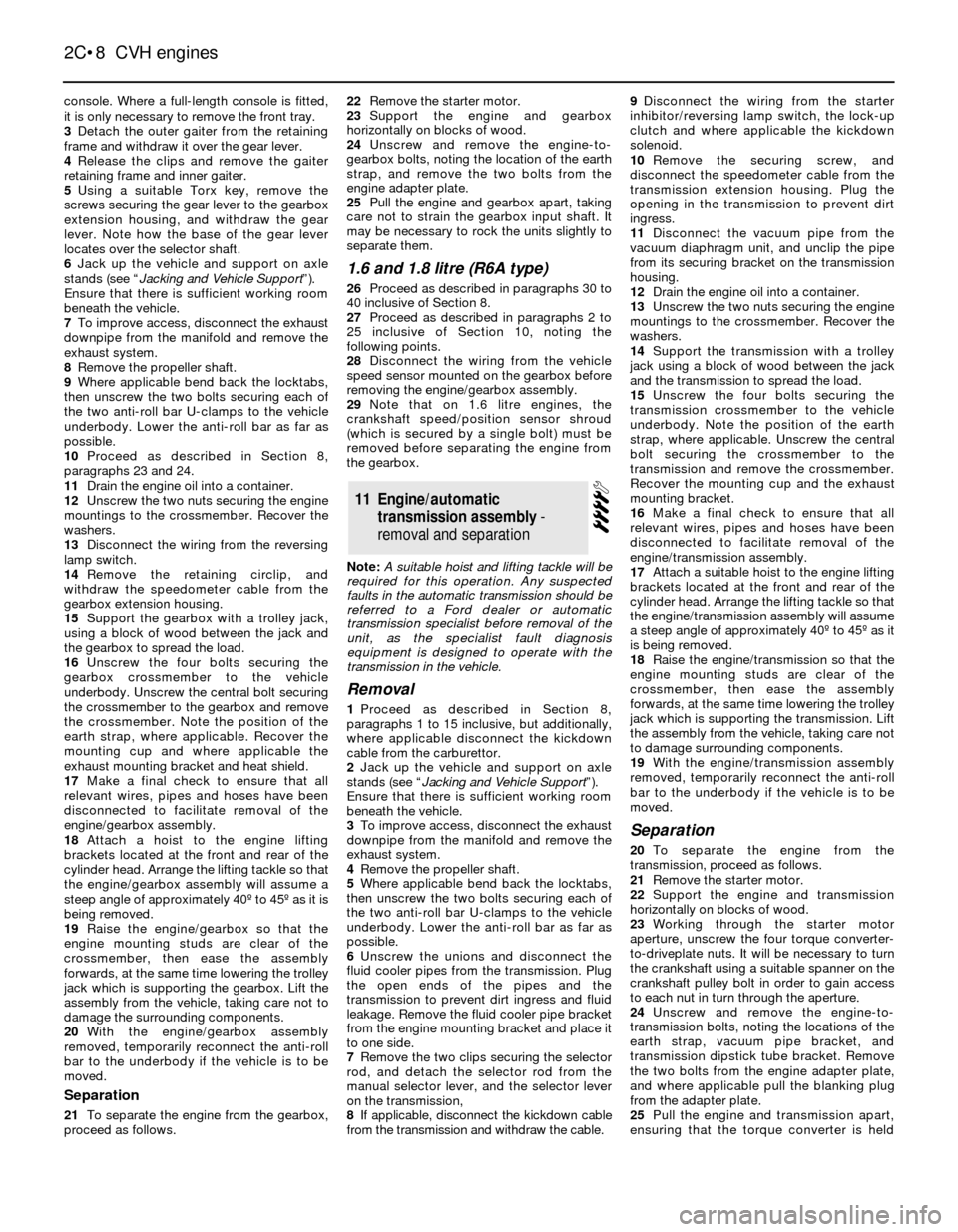
console. Where a full-length console is fitted,
it is only necessary to remove the front tray.
3Detach the outer gaiter from the retaining
frame and withdraw it over the gear lever.
4Release the clips and remove the gaiter
retaining frame and inner gaiter.
5Using a suitable Torx key, remove the
screws securing the gear lever to the gearbox
extension housing, and withdraw the gear
lever. Note how the base of the gear lever
locates over the selector shaft.
6Jack up the vehicle and support on axle
stands (see “Jacking and Vehicle Support”).
Ensure that there is sufficient working room
beneath the vehicle.
7To improve access, disconnect the exhaust
downpipe from the manifold and remove the
exhaust system.
8Remove the propeller shaft.
9Where applicable bend back the locktabs,
then unscrew the two bolts securing each of
the two anti-roll bar U-clamps to the vehicle
underbody. Lower the anti-roll bar as far as
possible.
10Proceed as described in Section 8,
paragraphs 23 and 24.
11Drain the engine oil into a container.
12Unscrew the two nuts securing the engine
mountings to the crossmember. Recover the
washers.
13Disconnect the wiring from the reversing
lamp switch.
14Remove the retaining circlip, and
withdraw the speedometer cable from the
gearbox extension housing.
15Support the gearbox with a trolley jack,
using a block of wood between the jack and
the gearbox to spread the load.
16Unscrew the four bolts securing the
gearbox crossmember to the vehicle
underbody. Unscrew the central bolt securing
the crossmember to the gearbox and remove
the crossmember. Note the position of the
earth strap, where applicable. Recover the
mounting cup and where applicable the
exhaust mounting bracket and heat shield.
17Make a final check to ensure that all
relevant wires, pipes and hoses have been
disconnected to facilitate removal of the
engine/gearbox assembly.
18Attach a hoist to the engine lifting
brackets located at the front and rear of the
cylinder head. Arrange the lifting tackle so that
the engine/gearbox assembly will assume a
steep angle of approximately 40º to 45º as it is
being removed.
19Raise the engine/gearbox so that the
engine mounting studs are clear of the
crossmember, then ease the assembly
forwards, at the same time lowering the trolley
jack which is supporting the gearbox. Lift the
assembly from the vehicle, taking care not to
damage the surrounding components.
20With the engine/gearbox assembly
removed, temporarily reconnect the anti-roll
bar to the underbody if the vehicle is to be
moved.
Separation
21To separate the engine from the gearbox,
proceed as follows. 22Remove the starter motor.
23Support the engine and gearbox
horizontally on blocks of wood.
24Unscrew and remove the engine-to-
gearbox bolts, noting the location of the earth
strap, and remove the two bolts from the
engine adapter plate.
25Pull the engine and gearbox apart, taking
care not to strain the gearbox input shaft. It
may be necessary to rock the units slightly to
separate them.
1.6 and 1.8 litre (R6A type)
26Proceed as described in paragraphs 30 to
40 inclusive of Section 8.
27Proceed as described in paragraphs 2 to
25 inclusive of Section 10, noting the
following points.
28Disconnect the wiring from the vehicle
speed sensor mounted on the gearbox before
removing the engine/gearbox assembly.
29Note that on 1.6 litre engines, the
crankshaft speed/position sensor shroud
(which is secured by a single bolt) must be
removed before separating the engine from
the gearbox.
Note: A suitable hoist and lifting tackle will be
required for this operation. Any suspected
faults in the automatic transmission should be
referred to a Ford dealer or automatic
transmission specialist before removal of the
unit, as the specialist fault diagnosis
equipment is designed to operate with the
transmission in the vehicle.
Removal
1Proceed as described in Section 8,
paragraphs 1 to 15 inclusive, but additionally,
where applicable disconnect the kickdown
cable from the carburettor.
2Jack up the vehicle and support on axle
stands (see “Jacking and Vehicle Support”).
Ensure that there is sufficient working room
beneath the vehicle.
3To improve access, disconnect the exhaust
downpipe from the manifold and remove the
exhaust system.
4Remove the propeller shaft.
5Where applicable bend back the locktabs,
then unscrew the two bolts securing each of
the two anti-roll bar U-clamps to the vehicle
underbody. Lower the anti-roll bar as far as
possible.
6Unscrew the unions and disconnect the
fluid cooler pipes from the transmission. Plug
the open ends of the pipes and the
transmission to prevent dirt ingress and fluid
leakage. Remove the fluid cooler pipe bracket
from the engine mounting bracket and place it
to one side.
7Remove the two clips securing the selector
rod, and detach the selector rod from the
manual selector lever, and the selector lever
on the transmission,
8If applicable, disconnect the kickdown cable
from the transmission and withdraw the cable.9Disconnect the wiring from the starter
inhibitor/reversing lamp switch, the lock-up
clutch and where applicable the kickdown
solenoid.
10Remove the securing screw, and
disconnect the speedometer cable from the
transmission extension housing. Plug the
opening in the transmission to prevent dirt
ingress.
11Disconnect the vacuum pipe from the
vacuum diaphragm unit, and unclip the pipe
from its securing bracket on the transmission
housing.
12Drain the engine oil into a container.
13Unscrew the two nuts securing the engine
mountings to the crossmember. Recover the
washers.
14Support the transmission with a trolley
jack using a block of wood between the jack
and the transmission to spread the load.
15Unscrew the four bolts securing the
transmission crossmember to the vehicle
underbody. Note the position of the earth
strap, where applicable. Unscrew the central
bolt securing the crossmember to the
transmission and remove the crossmember.
Recover the mounting cup and the exhaust
mounting bracket.
16Make a final check to ensure that all
relevant wires, pipes and hoses have been
disconnected to facilitate removal of the
engine/transmission assembly.
17Attach a suitable hoist to the engine lifting
brackets located at the front and rear of the
cylinder head. Arrange the lifting tackle so that
the engine/transmission assembly will assume
a steep angle of approximately 40º to 45º as it
is being removed.
18Raise the engine/transmission so that the
engine mounting studs are clear of the
crossmember, then ease the assembly
forwards, at the same time lowering the trolley
jack which is supporting the transmission. Lift
the assembly from the vehicle, taking care not
to damage surrounding components.
19With the engine/transmission assembly
removed, temporarily reconnect the anti-roll
bar to the underbody if the vehicle is to be
moved.
Separation
20To separate the engine from the
transmission, proceed as follows.
21Remove the starter motor.
22Support the engine and transmission
horizontally on blocks of wood.
23Working through the starter motor
aperture, unscrew the four torque converter-
to-driveplate nuts. It will be necessary to turn
the crankshaft using a suitable spanner on the
crankshaft pulley bolt in order to gain access
to each nut in turn through the aperture.
24Unscrew and remove the engine-to-
transmission bolts, noting the locations of the
earth strap, vacuum pipe bracket, and
transmission dipstick tube bracket. Remove
the two bolts from the engine adapter plate,
and where applicable pull the blanking plug
from the adapter plate.
25Pull the engine and transmission apart,
ensuring that the torque converter is held
11Engine/automatic
transmission assembly -
removal and separation
2C•8CVH engines
Page 11 of 24
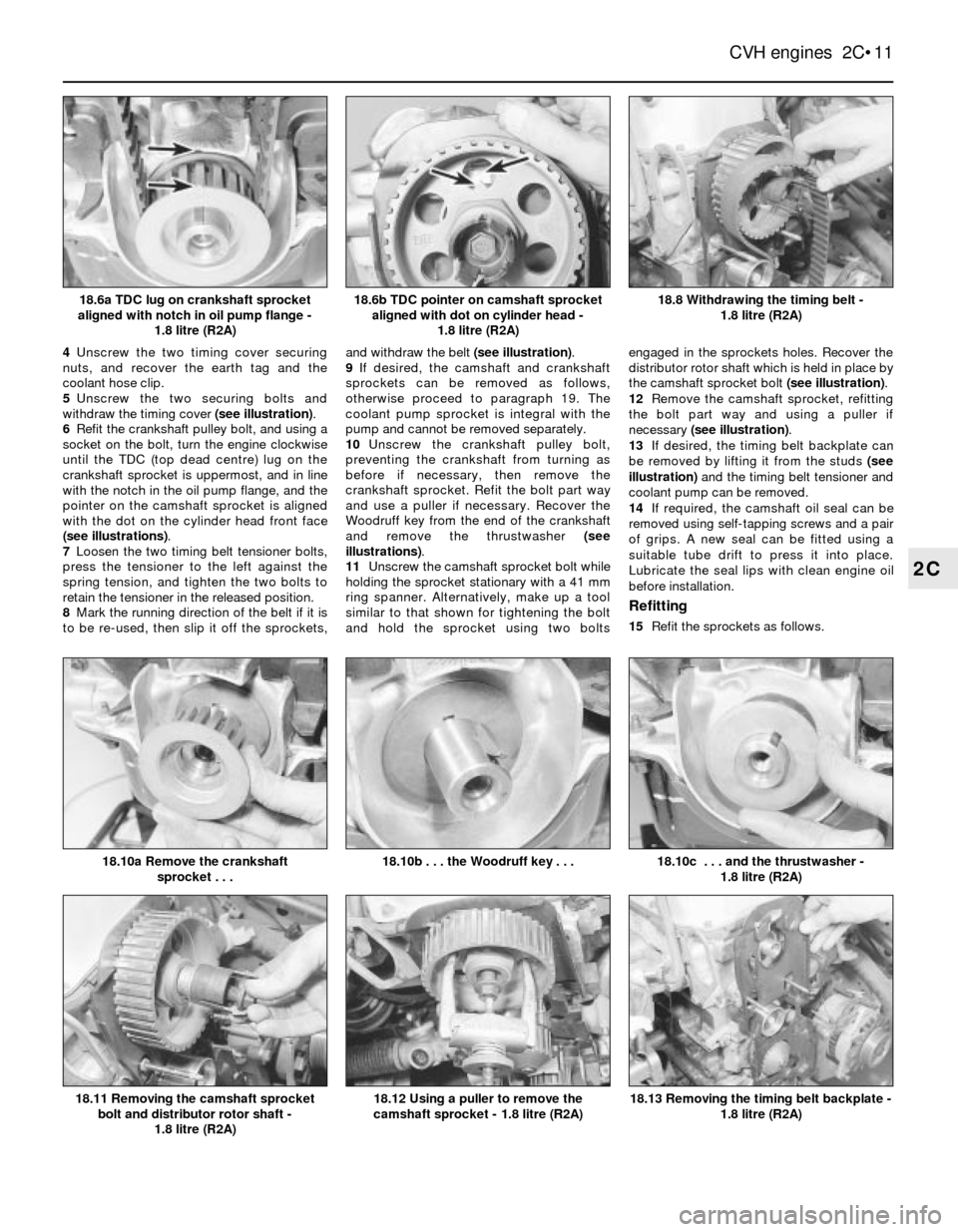
4Unscrew the two timing cover securing
nuts, and recover the earth tag and the
coolant hose clip.
5Unscrew the two securing bolts and
withdraw the timing cover (see illustration).
6Refit the crankshaft pulley bolt, and using a
socket on the bolt, turn the engine clockwise
until the TDC (top dead centre) lug on the
crankshaft sprocket is uppermost, and in line
with the notch in the oil pump flange, and the
pointer on the camshaft sprocket is aligned
with the dot on the cylinder head front face
(see illustrations).
7Loosen the two timing belt tensioner bolts,
press the tensioner to the left against the
spring tension, and tighten the two bolts to
retain the tensioner in the released position.
8Mark the running direction of the belt if it is
to be re-used, then slip it off the sprockets,and withdraw the belt (see illustration).
9If desired, the camshaft and crankshaft
sprockets can be removed as follows,
otherwise proceed to paragraph 19. The
coolant pump sprocket is integral with the
pump and cannot be removed separately.
10Unscrew the crankshaft pulley bolt,
preventing the crankshaft from turning as
before if necessary, then remove the
crankshaft sprocket. Refit the bolt part way
and use a puller if necessary. Recover the
Woodruff key from the end of the crankshaft
and remove the thrustwasher (see
illustrations).
11Unscrew the camshaft sprocket bolt while
holding the sprocket stationary with a 41 mm
ring spanner. Alternatively, make up a tool
similar to that shown for tightening the bolt
and hold the sprocket using two boltsengaged in the sprockets holes. Recover the
distributor rotor shaft which is held in place by
the camshaft sprocket bolt (see illustration).
12Remove the camshaft sprocket, refitting
the bolt part way and using a puller if
necessary (see illustration).
13If desired, the timing belt backplate can
be removed by lifting it from the studs (see
illustration)and the timing belt tensioner and
coolant pump can be removed.
14If required, the camshaft oil seal can be
removed using self-tapping screws and a pair
of grips. A new seal can be fitted using a
suitable tube drift to press it into place.
Lubricate the seal lips with clean engine oil
before installation.
Refitting
15Refit the sprockets as follows.
CVH engines 2C•11
2C
18.8 Withdrawing the timing belt -
1.8 litre (R2A)
18.13 Removing the timing belt backplate -
1.8 litre (R2A)18.12 Using a puller to remove the
camshaft sprocket - 1.8 litre (R2A)18.11 Removing the camshaft sprocket
bolt and distributor rotor shaft -
1.8 litre (R2A)
18.10c . . . and the thrustwasher -
1.8 litre (R2A)18.10b . . . the Woodruff key . . .18.10a Remove the crankshaft
sprocket . . .
18.6b TDC pointer on camshaft sprocket
aligned with dot on cylinder head -
1.8 litre (R2A)18.6a TDC lug on crankshaft sprocket
aligned with notch in oil pump flange -
1.8 litre (R2A)
Page 12 of 24
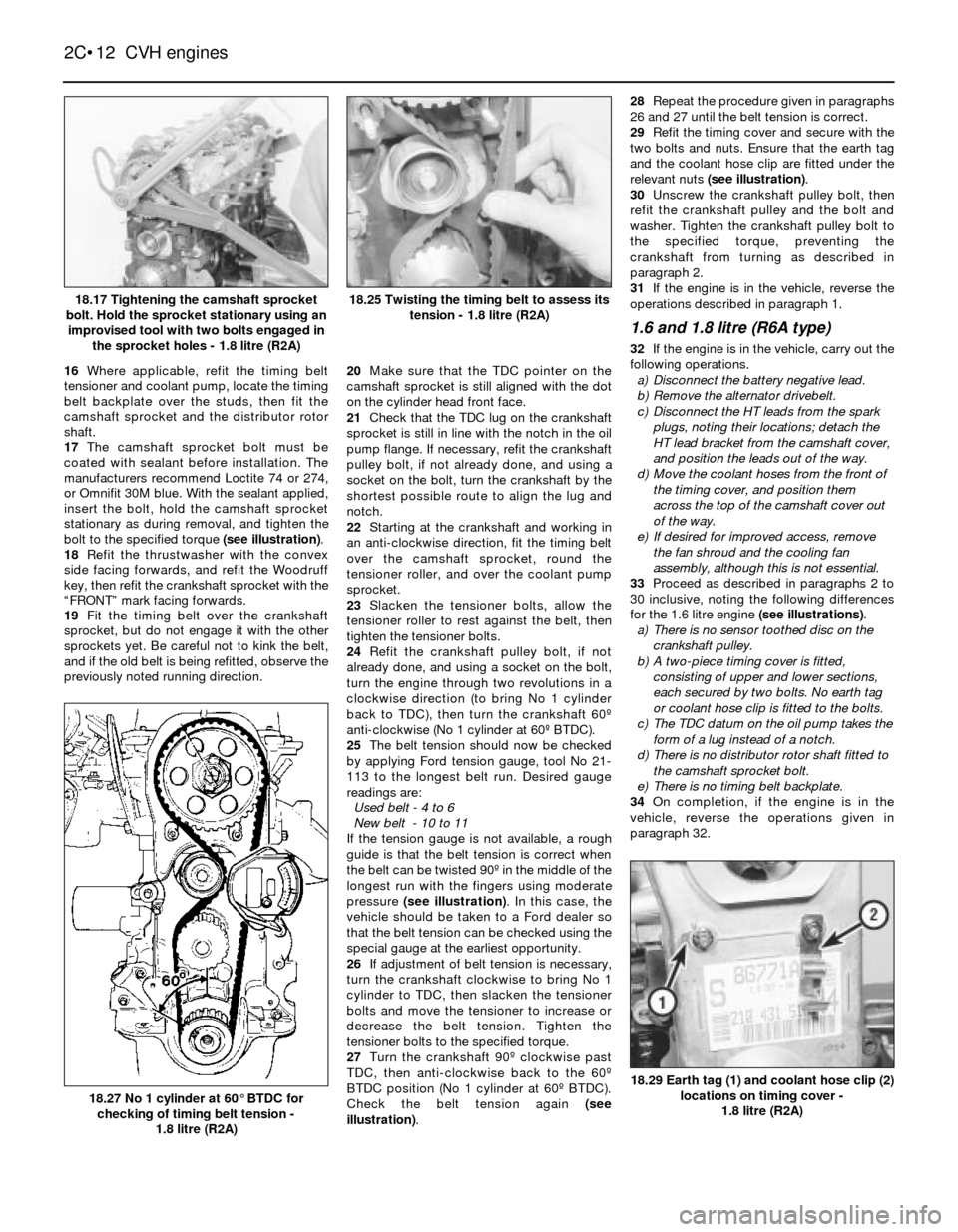
16Where applicable, refit the timing belt
tensioner and coolant pump, locate the timing
belt backplate over the studs, then fit the
camshaft sprocket and the distributor rotor
shaft.
17The camshaft sprocket bolt must be
coated with sealant before installation. The
manufacturers recommend Loctite 74 or 274,
or Omnifit 30M blue. With the sealant applied,
insert the bolt, hold the camshaft sprocket
stationary as during removal, and tighten the
bolt to the specified torque (see illustration).
18Refit the thrustwasher with the convex
side facing forwards, and refit the Woodruff
key, then refit the crankshaft sprocket with the
“FRONT” mark facing forwards.
19Fit the timing belt over the crankshaft
sprocket, but do not engage it with the other
sprockets yet. Be careful not to kink the belt,
and if the old belt is being refitted, observe the
previously noted running direction.20Make sure that the TDC pointer on the
camshaft sprocket is still aligned with the dot
on the cylinder head front face.
21Check that the TDC lug on the crankshaft
sprocket is still in line with the notch in the oil
pump flange. If necessary, refit the crankshaft
pulley bolt, if not already done, and using a
socket on the bolt, turn the crankshaft by the
shortest possible route to align the lug and
notch.
22Starting at the crankshaft and working in
an anti-clockwise direction, fit the timing belt
over the camshaft sprocket, round the
tensioner roller, and over the coolant pump
sprocket.
23Slacken the tensioner bolts, allow the
tensioner roller to rest against the belt, then
tighten the tensioner bolts.
24Refit the crankshaft pulley bolt, if not
already done, and using a socket on the bolt,
turn the engine through two revolutions in a
clockwise direction (to bring No 1 cylinder
back to TDC), then turn the crankshaft 60º
anti-clockwise (No 1 cylinder at 60º BTDC).
25The belt tension should now be checked
by applying Ford tension gauge, tool No 21-
113 to the longest belt run. Desired gauge
readings are:
Used belt - 4 to 6
New belt - 10 to 11
If the tension gauge is not available, a rough
guide is that the belt tension is correct when
the belt can be twisted 90º in the middle of the
longest run with the fingers using moderate
pressure (see illustration). In this case, the
vehicle should be taken to a Ford dealer so
that the belt tension can be checked using the
special gauge at the earliest opportunity.
26If adjustment of belt tension is necessary,
turn the crankshaft clockwise to bring No 1
cylinder to TDC, then slacken the tensioner
bolts and move the tensioner to increase or
decrease the belt tension. Tighten the
tensioner bolts to the specified torque.
27Turn the crankshaft 90º clockwise past
TDC, then anti-clockwise back to the 60º
BTDC position (No 1 cylinder at 60º BTDC).
Check the belt tension again (see
illustration).28Repeat the procedure given in paragraphs
26 and 27 until the belt tension is correct.
29Refit the timing cover and secure with the
two bolts and nuts. Ensure that the earth tag
and the coolant hose clip are fitted under the
relevant nuts (see illustration).
30Unscrew the crankshaft pulley bolt, then
refit the crankshaft pulley and the bolt and
washer. Tighten the crankshaft pulley bolt to
the specified torque, preventing the
crankshaft from turning as described in
paragraph 2.
31If the engine is in the vehicle, reverse the
operations described in paragraph 1.
1.6 and 1.8 litre (R6A type)
32If the engine is in the vehicle, carry out the
following operations.
a)Disconnect the battery negative lead.
b)Remove the alternator drivebelt.
c)Disconnect the HT leads from the spark
plugs, noting their locations; detach the
HT lead bracket from the camshaft cover,
and position the leads out of the way.
d)Move the coolant hoses from the front of
the timing cover, and position them
across the top of the camshaft cover out
of the way.
e)If desired for improved access, remove
the fan shroud and the cooling fan
assembly, although this is not essential.
33Proceed as described in paragraphs 2 to
30 inclusive, noting the following differences
for the 1.6 litre engine (see illustrations).
a)There is no sensor toothed disc on the
crankshaft pulley.
b)A two-piece timing cover is fitted,
consisting of upper and lower sections,
each secured by two bolts. No earth tag
or coolant hose clip is fitted to the bolts.
c)The TDC datum on the oil pump takes the
form of a lug instead of a notch.
d)There is no distributor rotor shaft fitted to
the camshaft sprocket bolt.
e)There is no timing belt backplate.
34On completion, if the engine is in the
vehicle, reverse the operations given in
paragraph 32.
2C•12CVH engines
18.17 Tightening the camshaft sprocket
bolt. Hold the sprocket stationary using an
improvised tool with two bolts engaged in
the sprocket holes - 1.8 litre (R2A)
18.27 No 1 cylinder at 60°BTDC for
checking of timing belt tension -
1.8 litre (R2A)
18.29 Earth tag (1) and coolant hose clip (2)
locations on timing cover -
1.8 litre (R2A)
18.25 Twisting the timing belt to assess its
tension - 1.8 litre (R2A)
Page 18 of 24
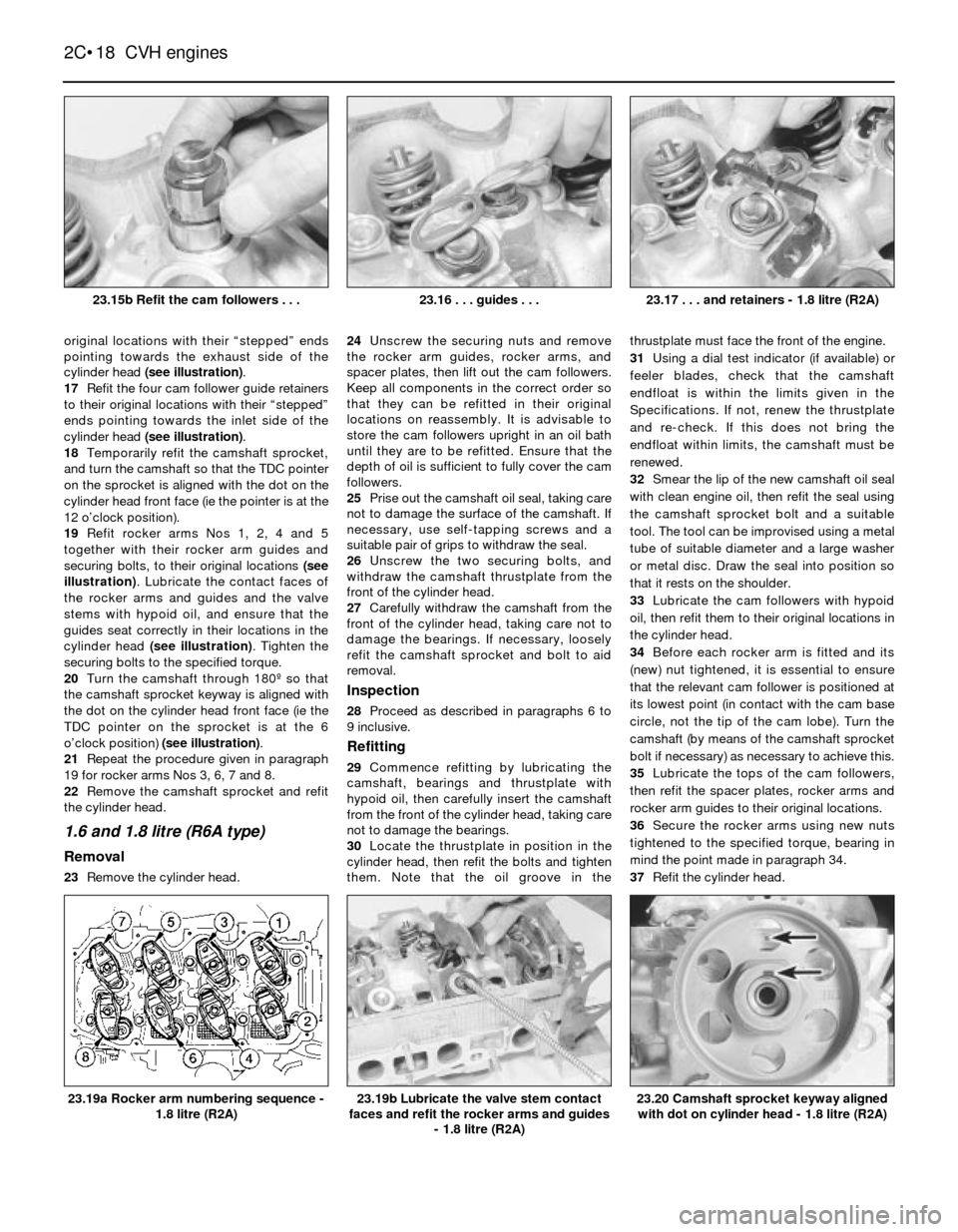
original locations with their “stepped” ends
pointing towards the exhaust side of the
cylinder head (see illustration).
17Refit the four cam follower guide retainers
to their original locations with their “stepped”
ends pointing towards the inlet side of the
cylinder head (see illustration).
18Temporarily refit the camshaft sprocket,
and turn the camshaft so that the TDC pointer
on the sprocket is aligned with the dot on the
cylinder head front face (ie the pointer is at the
12 o’clock position).
19Refit rocker arms Nos 1, 2, 4 and 5
together with their rocker arm guides and
securing bolts, to their original locations (see
illustration). Lubricate the contact faces of
the rocker arms and guides and the valve
stems with hypoid oil, and ensure that the
guides seat correctly in their locations in the
cylinder head (see illustration). Tighten the
securing bolts to the specified torque.
20Turn the camshaft through 180º so that
the camshaft sprocket keyway is aligned with
the dot on the cylinder head front face (ie the
TDC pointer on the sprocket is at the 6
o’clock position) (see illustration).
21Repeat the procedure given in paragraph
19 for rocker arms Nos 3, 6, 7 and 8.
22Remove the camshaft sprocket and refit
the cylinder head.
1.6 and 1.8 litre (R6A type)
Removal
23Remove the cylinder head. 24Unscrew the securing nuts and remove
the rocker arm guides, rocker arms, and
spacer plates, then lift out the cam followers.
Keep all components in the correct order so
that they can be refitted in their original
locations on reassembly. It is advisable to
store the cam followers upright in an oil bath
until they are to be refitted. Ensure that the
depth of oil is sufficient to fully cover the cam
followers.
25Prise out the camshaft oil seal, taking care
not to damage the surface of the camshaft. If
necessary, use self-tapping screws and a
suitable pair of grips to withdraw the seal.
26Unscrew the two securing bolts, and
withdraw the camshaft thrustplate from the
front of the cylinder head.
27Carefully withdraw the camshaft from the
front of the cylinder head, taking care not to
damage the bearings. If necessary, loosely
refit the camshaft sprocket and bolt to aid
removal.
Inspection
28Proceed as described in paragraphs 6 to
9 inclusive.
Refitting
29Commence refitting by lubricating the
camshaft, bearings and thrustplate with
hypoid oil, then carefully insert the camshaft
from the front of the cylinder head, taking care
not to damage the bearings.
30Locate the thrustplate in position in the
cylinder head, then refit the bolts and tighten
them. Note that the oil groove in thethrustplate must face the front of the engine.
31Using a dial test indicator (if available) or
feeler blades, check that the camshaft
endfloat is within the limits given in the
Specifications. If not, renew the thrustplate
and re-check. If this does not bring the
endfloat within limits, the camshaft must be
renewed.
32Smear the lip of the new camshaft oil seal
with clean engine oil, then refit the seal using
the camshaft sprocket bolt and a suitable
tool. The tool can be improvised using a metal
tube of suitable diameter and a large washer
or metal disc. Draw the seal into position so
that it rests on the shoulder.
33Lubricate the cam followers with hypoid
oil, then refit them to their original locations in
the cylinder head.
34Before each rocker arm is fitted and its
(new) nut tightened, it is essential to ensure
that the relevant cam follower is positioned at
its lowest point (in contact with the cam base
circle, not the tip of the cam lobe). Turn the
camshaft (by means of the camshaft sprocket
bolt if necessary) as necessary to achieve this.
35Lubricate the tops of the cam followers,
then refit the spacer plates, rocker arms and
rocker arm guides to their original locations.
36Secure the rocker arms using new nuts
tightened to the specified torque, bearing in
mind the point made in paragraph 34.
37Refit the cylinder head.
2C•18CVH engines
23.17 . . . and retainers - 1.8 litre (R2A)
23.20 Camshaft sprocket keyway aligned
with dot on cylinder head - 1.8 litre (R2A)23.19b Lubricate the valve stem contact
faces and refit the rocker arms and guides
- 1.8 litre (R2A)23.19a Rocker arm numbering sequence -
1.8 litre (R2A)
23.16 . . . guides . . .23.15b Refit the cam followers . . .
Page 20 of 24
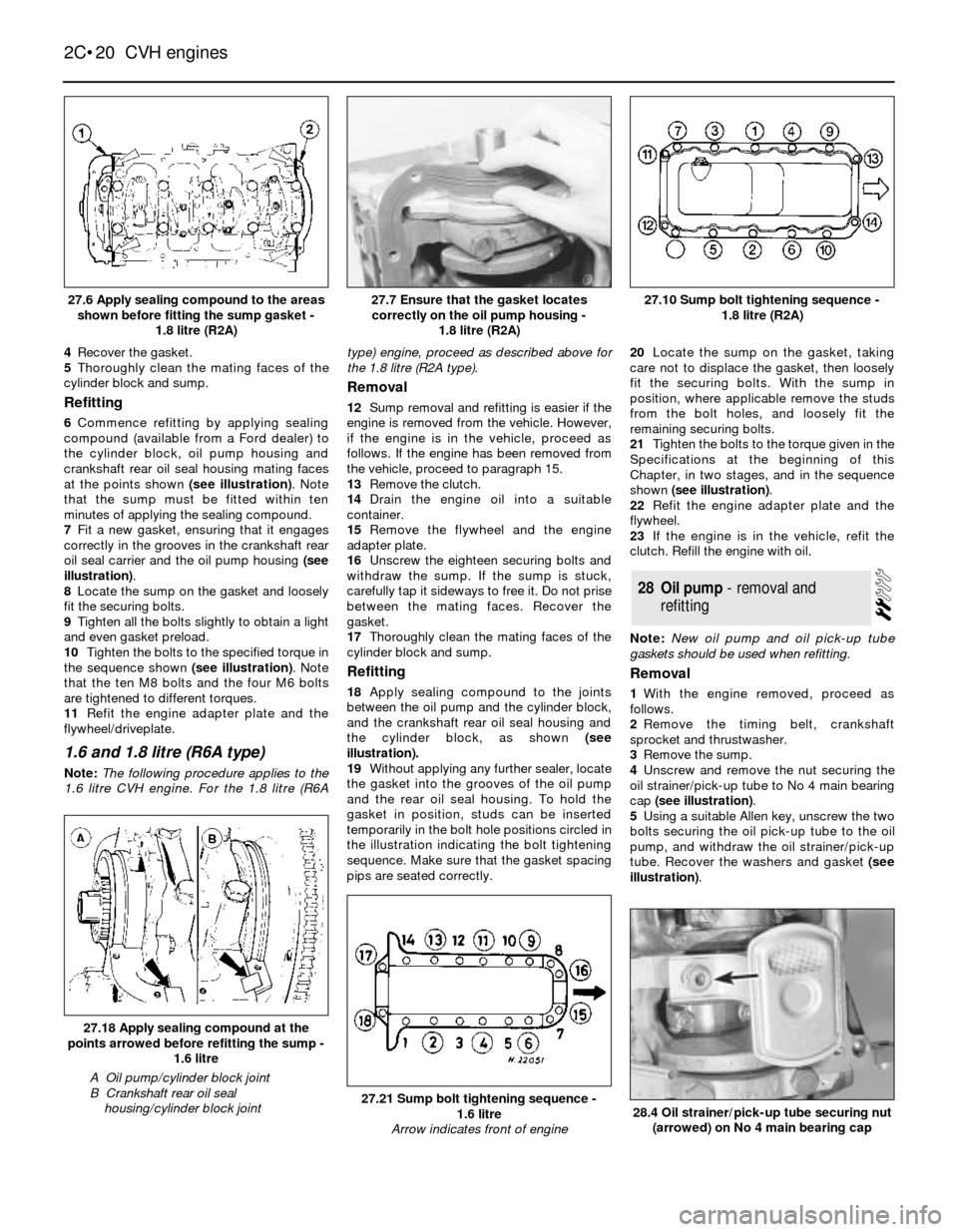
4Recover the gasket.
5Thoroughly clean the mating faces of the
cylinder block and sump.
Refitting
6Commence refitting by applying sealing
compound (available from a Ford dealer) to
the cylinder block, oil pump housing and
crankshaft rear oil seal housing mating faces
at the points shown (see illustration). Note
that the sump must be fitted within ten
minutes of applying the sealing compound.
7Fit a new gasket, ensuring that it engages
correctly in the grooves in the crankshaft rear
oil seal carrier and the oil pump housing (see
illustration).
8Locate the sump on the gasket and loosely
fit the securing bolts.
9Tighten all the bolts slightly to obtain a light
and even gasket preload.
10Tighten the bolts to the specified torque in
the sequence shown (see illustration). Note
that the ten M8 bolts and the four M6 bolts
are tightened to different torques.
11Refit the engine adapter plate and the
flywheel/driveplate.
1.6 and 1.8 litre (R6A type)
Note: The following procedure applies to the
1.6 litre CVH engine. For the 1.8 litre (R6Atype) engine, proceed as described above for
the 1.8 litre (R2A type).
Removal
12Sump removal and refitting is easier if the
engine is removed from the vehicle. However,
if the engine is in the vehicle, proceed as
follows. If the engine has been removed from
the vehicle, proceed to paragraph 15.
13Remove the clutch.
14Drain the engine oil into a suitable
container.
15Remove the flywheel and the engine
adapter plate.
16Unscrew the eighteen securing bolts and
withdraw the sump. If the sump is stuck,
carefully tap it sideways to free it. Do not prise
between the mating faces. Recover the
gasket.
17Thoroughly clean the mating faces of the
cylinder block and sump.
Refitting
18Apply sealing compound to the joints
between the oil pump and the cylinder block,
and the crankshaft rear oil seal housing and
the cylinder block, as shown (see
illustration).
19Without applying any further sealer, locate
the gasket into the grooves of the oil pump
and the rear oil seal housing. To hold the
gasket in position, studs can be inserted
temporarily in the bolt hole positions circled in
the illustration indicating the bolt tightening
sequence. Make sure that the gasket spacing
pips are seated correctly.20Locate the sump on the gasket, taking
care not to displace the gasket, then loosely
fit the securing bolts. With the sump in
position, where applicable remove the studs
from the bolt holes, and loosely fit the
remaining securing bolts.
21Tighten the bolts to the torque given in the
Specifications at the beginning of this
Chapter, in two stages, and in the sequence
shown (see illustration).
22Refit the engine adapter plate and the
flywheel.
23If the engine is in the vehicle, refit the
clutch. Refill the engine with oil.
Note: New oil pump and oil pick-up tube
gaskets should be used when refitting.
Removal
1With the engine removed, proceed as
follows.
2Remove the timing belt, crankshaft
sprocket and thrustwasher.
3Remove the sump.
4Unscrew and remove the nut securing the
oil strainer/pick-up tube to No 4 main bearing
cap (see illustration).
5Using a suitable Allen key, unscrew the two
bolts securing the oil pick-up tube to the oil
pump, and withdraw the oil strainer/pick-up
tube. Recover the washers and gasket (see
illustration).
28Oil pump - removal and
refitting
2C•20CVH engines
27.6 Apply sealing compound to the areas
shown before fitting the sump gasket -
1.8 litre (R2A)27.10 Sump bolt tightening sequence -
1.8 litre (R2A)
27.21 Sump bolt tightening sequence -
1.6 litre
Arrow indicates front of engine
27.18 Apply sealing compound at the
points arrowed before refitting the sump -
1.6 litre
A Oil pump/cylinder block joint
B Crankshaft rear oil seal
housing/cylinder block joint
27.7 Ensure that the gasket locates
correctly on the oil pump housing -
1.8 litre (R2A)
28.4 Oil strainer/pick-up tube securing nut
(arrowed) on No 4 main bearing cap